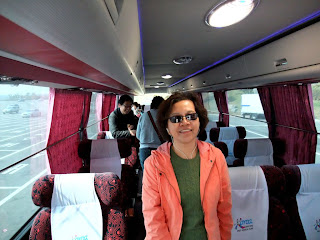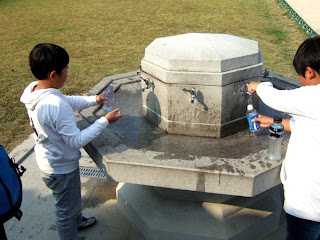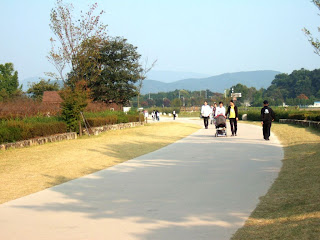
The luxurious express bus offered to foreigners to visit the ancient capital of Silla Kingdom, Gyeongju, absolutely free of charge by Korea Tourism Board in the month of October. The bus was as comfortable as a business class seat on flight. It took about 5 hours from Seoul.
Gyeongju, covered an area of 2800 ha, with a population of 350,000 people was an ancient capital when Korea was ruled by Silla Kingdom from 57 BC to 935 AD. It is a superb showcase of the kingdom's achievements, a window to the past and a museum without walls. Gyeongju is one of ten world's most historic sites.


Many local typical food offered at the stores within the rest area along the highway, the best among all was its chili sauce fish paste stick.


The beautiful drive way to Bomun Lake which was the first destination arrived in Gyeongju.


Bomun Lake, located to the east of Gyeongju town is a man-made lake with an area of 1,653,000 sq.meters.


Many 5 stars deluxe hotels situated within the area as there are many leisure facilities including golf course, spa resort, casino and amusement park.




There is a scenic walking path and bicycle lanes along the lake.



Bomun Lake is the best resort park in town for tourists to enjoy shopping, dining, pleasure boating and also hot-spring.


The ancient carriage Oxcart at the beautiful park near Bomun Lake.


A huge wooden turning wheel for distribution of water at the park.



A picturesque park where wooden water turning wheel, thatched hut, stone bridge, dense pines and colorful blossom flowers sharing the same living circumstances.


Lines of restaurants at the park ground with a huge stone grinder as a landmark.


Both sides of the road leading to Imhaejeon site were trees, rice fields and pink Azaleas flowers. A true scenic way.




Imhaejeon site, originally named as Wolji, is commonly known as Anapji Pond since Joseon period, as there were many wild geese and ducks visited and settled down at this long abandoned place. 'An' means goose and ' ap' means duck in Korean Chinese Character at that time.


Anapji Pond covers an area extending nearly 200 meters to 4 sides. Beautiful combination scenery of maple autumn foliage and pink azaleas at one of the direction.



The pond and mounds were created during King Munmu' period, with plants and rare animals from the palace.


The compound of Anapji was the detached palace of Silla which was built in 674 AD.




Garden was restored in the style of unified Silla period, with scientifically designed water supply and drainage.


A boat and relics of Silla artifacts, excavated in 1974 when the pond was drained are now housed in Gyeongju National Museum.


In order to keep the pond alive with clear flow of water, there are volunteering workers regularly clearing away the hyacinth from the pond


Anapji Pond sits on the ruined site of the palace and palatial buildings of Silla Kingdom, northeast of Gyeongju..



Anapji Pond appears no difference from any Japanese or Chinese Gardens but it allows nature to be as it is like most of Korean Gardens, emphasizing on no artificiality. The pond harmoniously exists with lily leaves and floating red foliage.




Donggung, the palace for Crown Prince to hold banquets celebrating occasions of the country was built on Anapji pond in the reign of King Munmu in 674 AD.


It was also the place where the letter of surrender was written to Wanggeon, the founder of Goryeo Dynasty.




The beautifully configured pond had three islets symbolizing the land of immortal deities !


It was fund to watch school boys enjoyed playing in stream water flowing down to the pond.



Appreciate that there always is a stone made circular structure at the tourist site to supply pure clean water for the visitors. Various views of the site.




Groups of school children while having their autumn outdoor courses also enjoyed the beautiful environment of Anapji Pond.


Vast horizon of rice farms with mountains and modern buildings as backdrop, along the rail of Gyeongju could be observed from another corner of Anapji Pond.



The nearby streets of Anapji Pond leading to Gyeongju town center, clean, tidy and beautifully taking care of.


The main entrance of Gyeongju National Museum. There was a bicycle parking along the gate with interesting propaganda phrases "Protect Korea for a complete land and unify" in Japanese language.


The Museum mainly displays the history and artifacts of the glorious period of Silla Dynasty 57 BC -992 AD). It houses more than 3000 pieces of relics discovered in many places of Gyeongju.


Gyeongju National Museum categorized into a few halls namely The Hall of Archeology, Anapji Hall, exhibition hall, Art Gallery and outdoor exhibition court. All treasures including dazzling golden crowns and Buddha Status are neatly and orderly displayed inside these halls accordingly through out the year.



The two pagodas at the outdoor exhibition court of Museum are the imitation of Seogatap and Dabotap of Bulguksa while the bell was the Divine Bell of King Seongdeok.



Anapji Hall was set at one corner with spectacular view of back drop with a comparison to its originals.


The Twin-turtle monument support at the monastic site of Sungboksa. The head was carved in the shape of dragon with pearls necklace while the back was like a turtle


The gorgeous Azaleas farm at the foot of the mountain. 36% of Gyeongju Town is national park.









The "flora" streets and round-about at town.




The bottle shaped Cheomseongdae Astronomical Observatory was built in 7th century for the early astronomers to watch the stars and moon, to predict eclipses and decide the planting times for the farmers.


The Observatory was built with 365 stones of 30cm in height, stacked in 27 tiers. 365 stones represented the number of days in a year and 27 tiers was to honor Queen Seondeol, the 27th ruler at that time when it was built. The square window facing south in the middle of the structure is believed to be an entrance to the top by ladder.



There are about 200 royal tombs found in Gyeongju. The ancient Silla Emperors were resting beneath the grassy burial which could be mounded up to as high as 23 meters. Bunhwangsa, one of the seven greatest Buddhist temples of Silla Dynasty, was built in the year 634. It had been visited by a few of nationally influential great monks from Korea. There was only one out of the three first imitation brick pagoda with its original nine levels standing in the compound of temple inside Bunhwangsa.


Gyeongju is wealth with historical buildings and treasures within its natural beautiful township. Just within its 10 sq. meter of land, it holds 25% of Korea's historical treasures.




The 10% of 200 royal tombs found in the city were inside Tumuli Park. Heavenly Horse Tomb Cheonmachong was unearthed in 1974 with more than 10 thousand royal ornaments, weapons etc. Among the 6th century valuable relics are the tall Silla Crown and Heavenly Horse Painting.


The Tomb in Tumuli Park is opened for viewing allowing visitors to understand how it was constructed and how various items were arranged in them. Dragon is the symbol of Dyeongju City as according to the history of 3-kingdoms, a dragon is said to have ascended from the pond to the east of the palace in the capital, Gyeongju.


Cycling was the best way to explore the historic city of Gyeongju.


Many of the shops outside the compound of Tumuli Park sells their local delicacy, red bean paste cake which were really good. We nearly missed one of the local noodle house as signboard indicated as Chinese Noodles House. The original taste of black sauce noodle "cha-cheong-mee" was so tasty, much much better than those I tried before.



Autumn is the season where Korean primary and secondary school children practiced the outdoor courses. They grouped up in classes with teachers and guardians. Almost all historic sites are within walking distance.




Saranchae Guest House ran by a local Korean couple, is a tradition house of Korea. Like most of the residential houses nearby, it was made of wood, clay, tile, brick, stone and thatch in Silla Style, most probably after mid-Joseon period. All rooms are built in with Ondol, the underfloor hypocaust heating system which made all guests warm while sleeping on the floor.



Chinese calligraphy wordings and phrases were written or hanged at walls at the central courtyard of the building.


The spacious courtyard at the center of the building, exactly like the ancient Chinese Houses.


Guest rooms and a warm gathering place for guests from all over the world to exchange experiences and information. We met people from Hungary, Netherlands, Canada, Indonesia, Thailand and USA.




Guests mainly are overseas foreigners from all corners of the world. This was the place where people without knowing each other, met and said hello, or had a cup of coffee together, or shared a couple of minutes. Most probable nobody would have chance to meet again after saying good0bye to Gyeongju.


The cultural corner at the guest house where many Korean antic are displayed. Mails, postcards and comments received from guests at all corners of our earth were pitched on the notice board.



The dining place where we met a family from USA and a single guy from Netherlands. They stayed for weeks or even months to enjoy the historic site of Gyeongju.


All kinds of utensils and grocery in the kitchen where guests are able to have a simple breakfast or prepare a simple dinner before or after exploring the place. The kind consideration of owner Mr and Mrs Choo, makes all guests at home.




The law of Gyeongju prohibits construction of any structure greater than 3-storey. All buildings must be in the style of Silla.



Houses with tiled pagoda roofs is a compulsory condition for new constructions.




The bright and beautiful flowers at the back yard of the guest house.


No comments:
Post a Comment